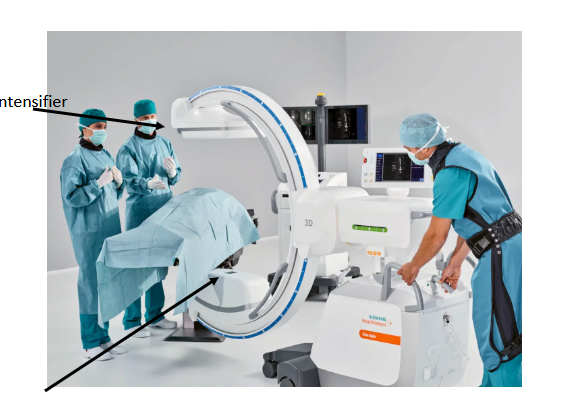Protection During C-Arm Fluoroscopy 2
0.0(0)
0.0(0)
Card Sorting
1/21
There's no tags or description
Looks like no tags are added yet.
Study Analytics
Name | Mastery | Learn | Test | Matching | Spaced |
|---|
No study sessions yet.
22 Terms
1
New cards
What is a C-arm?
A C-arm is a form of fluoroscopy that produces both still and live X-ray images.
2
New cards
Who often manages or operates the C-arm?
Many practitioners who operate the C-arm are not radiologists.
3
New cards
Do all C-arm operators have formal radiation safety training?
No. Many practitioners managing the C-arm do not have the same radiation safety training that radiologists and radiologic technologists receive.
4
New cards
What type of radiation exposure is mainly produced by the C-arm?
Scatter radiation from the patient.
5
New cards
Where does most of the scatter radiation come from during C-arm use?
Most scatter radiation comes from the side closest to the X-ray tube, where the X-rays originate.
6
New cards
What is the safest position relative to the C-arm during use?
Standing on the side away from the X-ray tube, opposite the source of radiation, is the safest position.
7
New cards

What is this in the image and what is labled on the top and bottom?
This is a c-arm and the top is the image intensifier and the bottom is the x-ray tube. It also good to note that this is the safest way to have it tube under table and intensifier above the table.
8
New cards
What happens to radiation dose with longer exposure times?
Longer amounts of exposure result in a higher radiation dose.
9
New cards
Why is radiation protection especially important during surgical procedures?
Surgical procedures are lengthy and require extensive X-ray use, increasing exposure risk.
10
New cards
What is the required lead equivalent for protective aprons during C-arm use?
The same as fluoroscopy—between 0.5 mm and 1 mm of lead.
11
New cards
Is radiation monitoring required for imaging personnel during C-arm procedures?
Yes. Appropriate radiation monitoring for imaging personnel is mandatory during C-arm use.
12
New cards
What is the best setup for minimizing exposure during C-arm procedures?
Position the X-ray tube underneath the table and the image intensifier above the table.
13
New cards
What is the best setup for minimizing exposure during c -arm procedures while the patient is lateral?
It would be the same as a normal C- arm procdure if they are supine which is tube underneath table and image intensifier above the table.
14
New cards
How can a technologist minimize radiation exposure during C-arm use?
Minimize beam-on time; if the surgeon is not looking at the image, turn off the beam and step away.
15
New cards
What does the cumulative timer on a C-arm do?
It alerts the user every 5 minutes of beam-on time to monitor total exposure.
16
New cards
What should be used to review or display images without additional exposure?
An image storage device — the last image can be displayed and moved to another screen for viewing.
17
New cards
Where should the image intensifier end of the C-arm be positioned?
Close to the patient to reduce scatter and improve image quality.
18
New cards
How should the X-ray beam be collimated during C-arm use?
Collimate tightly to the anatomy of interest to reduce patient and personnel dose.
19
New cards
What is an important general rule for reducing radiation exposure?
Use distance whenever possible; increasing distance reduces dose according to the inverse square law.
20
New cards
Why should magnification mode be used sparingly?
Magnification increases radiation dose; it should only be changed at the physician’s request.
21
New cards
Where should the X-ray tube be positioned during C-arm procedures?
The tube should be on the bottom, with the image intensifier on top, so scatter is directed toward the floor and not toward workers.
22
New cards
Why is it safer to keep the X-ray tube under the table?
Because scatter radiation will be directed downward and around the room, reducing exposure to staff.